#aren't just plain white. The weird thing is that the material it's made out of (maybe some sort of leather or something) absorbs sharpie?
Text

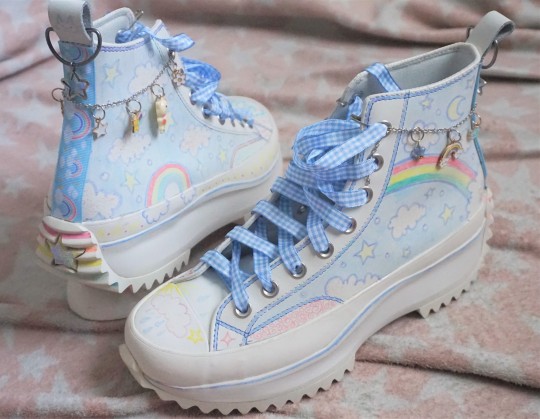
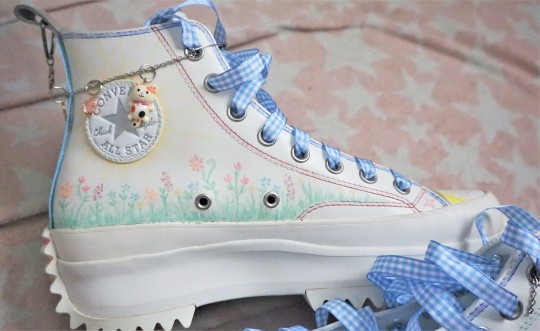
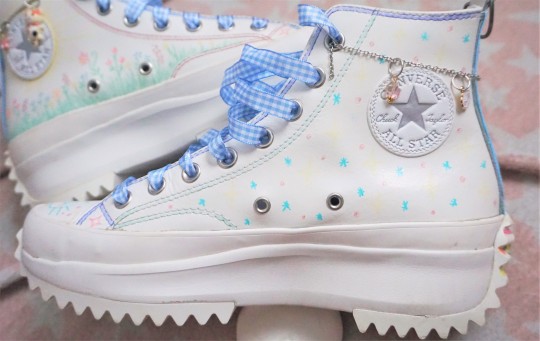
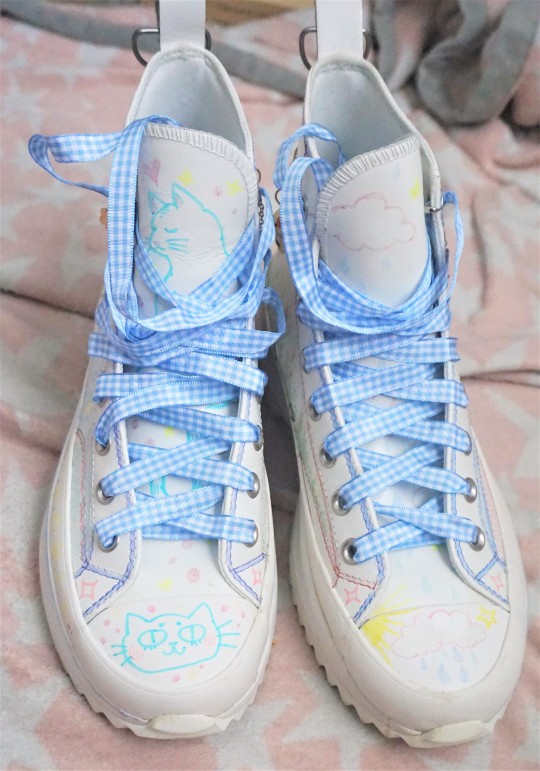
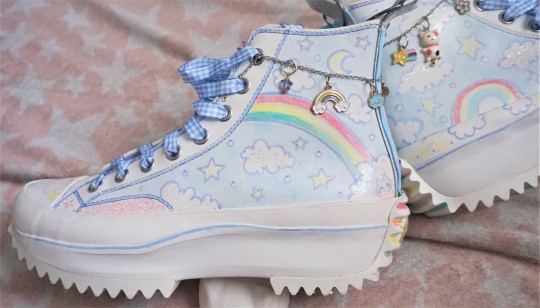

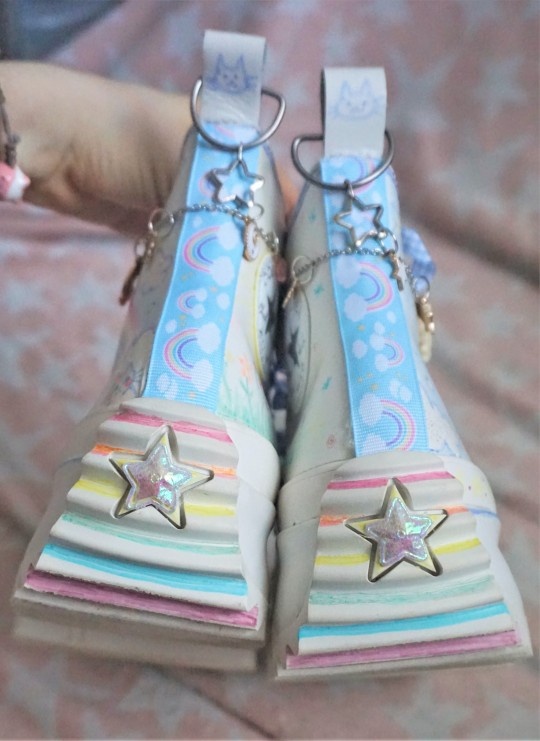
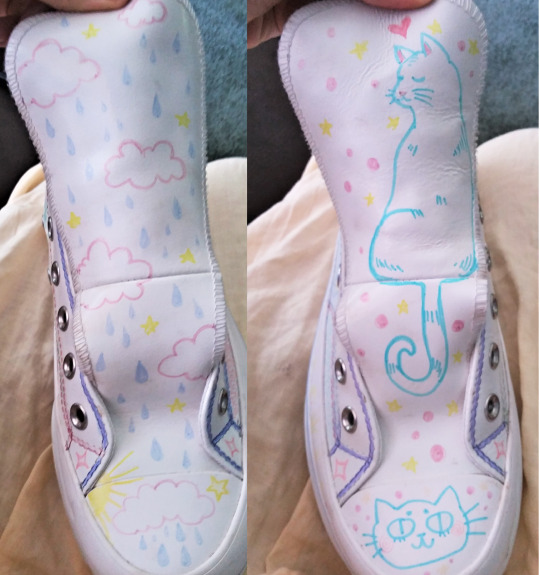

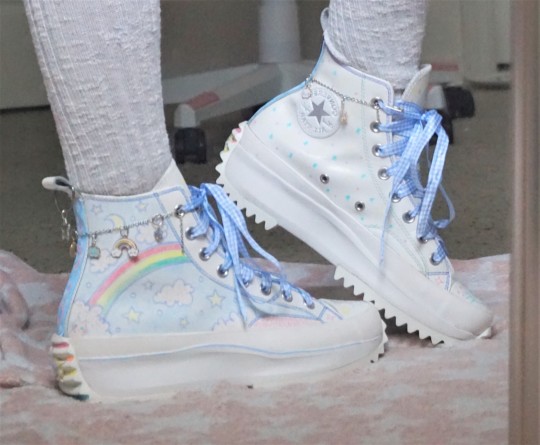
I got these shoes from someone recently but thought they were way too plain looking, so I set out on a quest to customize them with some sharpies and charms and miscellaneous ribbon I had in my craft drawers. Mostly sky themed (clouds, rainbows, rain, stars, etc.) because that's my favorite aesthetic, but I had to include some cat imagery as well, of course lol.
#also honestly had NO IDEA that real converse have that star logo on the INSIDE not the outer part??? why the hell would you want it on the#inner portion where nobody can see it?? my entire life I always would have sworn it was on the outer facing portion..#I think these would be perfect IF they were just slightly taller (top part higher above ankles instead of just weird hard material digging#right into your ankle whenever you walk) and if they were actual good platforms. they're so short. It's good that 'chunky' shoes are gettin#more popular as they've always been my favorite Look ever since I had these shoes with roller skates that pop out of thebottom (not heelys.#but like. before those. it was two whole entire roller skate wheels like a normal pair of roller skates) and the bottoms were so tall and#clunky and it made my feet look giant (because it had.. entire wheels in the bottom pockets lol). so#I've alwatys been into the aesthetic but . still I find a lot of the 'brands jumping on trend' are too short of platforms#OR they're plafrorms with a raised back/heel/wedge which to me is not aesthetically good and also makes them exceptionally uncomfortable to#wear compared to just plain completely flat chunky platform bottoms. ANYWAY.. if these shoes had a 3 or 4 inch platform I think they'd be#cooler. however for what they are it's still fine! and I like them more now that they actually have some sort of anything to them and#aren't just plain white. The weird thing is that the material it's made out of (maybe some sort of leather or something) absorbs sharpie?#the color changes over time. You draw a mark and then leave it for a few days and it either fades into being barely there or has changed#colors. so I had to go back in and redo parts. ALSO the shoe chains are so funny because I did NOT have the right tools for them#I don't have the stuff to make bracelets or open and close the little rings. they're held onto the shoe with just safety pins and the actua#little rung things that hold the charms on half of them are like broken or the metal is just jam smushed together bent and warped hhbjhjhb#I actually like the back a lot where there's the irridecent star thing hot glued on there. it's cool and shiny. and the clouds#are sparkly on the main parts of the shoe though I'm not sure how well it shows up in pictures#ANYWAY... shoegs..... If I were rich this is one of the things I would definitely custom order from craftsman#why would I spend like thousands of dollars on plain ass shoes that are just expensive because they're a Luxury Brand when I could literall#like pay people to create me custom shoes to my exact specifications?? I could have like 5 inch flat platform boots with fur andclouds#and cat shaped holes in the bottom with LEDs in them with pom pom and charms and etc. etc. etc. Like as gaudy and excessively over#decorated as I want lol.. AND they could have skates in the bottom somehow!! ghjgbhjb#this on top of all the custom wizard costumes and period clothing I would order.. Like i LOVE customizing things. I love everything in my l#life being as particualr as possible and cultivating every experience I have to meticulously meet my own specific criteria as much#as is possible. If I had the money to I would never buy something from a store again. EVERYTHING I owned from furniture to clothing#would be either made by me - or mostly - comissioned from craftsmen. custom tiles for my floors. custom bed. custom table.#even like. custom toilet. custom sinks. etc. etc. ouGGH... but yeah.. anyway... shoes..
145 notes
·
View notes
Text
The Basics Of American Revolutionary War Uniforms:
Basic descriptions I wrote of each layer of a Continental Army soldier's uniform in order of what you'd put on first to what you'd put on last, starting with:
Shirts:
In the 18th century, a man with a shirt was considered naked, so the shirt was a part of every outfit (although it was often covered in other layers of clothing). The shirts worn by the soldiers in the revolution were designed to be as comfortable as humanly possible, so they were very long, often stopping mid-thigh or just below the knee, loose and flowy, and had lots of ruffles at the top. Shirts also had long, puffy sleeves. The shirts were so comfortable that they would function as nightgowns too. All a man had to do to get ready for bed was take off all of the other layers of his uniform. The shirts were plain white or a yellowish colour, depending on how many times they'd been worn. Collars were high but not as high as collars in the 1790s, and sleeve cuffs were either closed by cuff links (little button things) or they'd just have cute lace at the end. Contrary to some ridiculous but funny assumptions I've heard from people who don't study historical fashion, shirts were not hard to put on, and they were simply pulled over the wearer's head like you would put on any other shirt. Shirts were closed together using buttons (a favourite of mine), linen, thread ties, or different combinations of the forementioned. Buttons tended to be small and made out of either thread, horn, leather, or even leather. Because the shirts were made out of soft, thin materials such as linen, cotton, and light flannel and were worn all the time, they were usually the first clothing items to wear out and break. Due to supply problems, there were periods of time during the revolution where men had to wear their breaking shirts and couldn't replace them. Another thing about shirts that I read somewhere (can not find the source for the life of me) is that Washington told his soldiers to wear hunting shirts because he felt that they were practical in every kind of weather. However, the site did say that they only wore them towards the start of the war and in certain regiments.
Neck accessories (for lack of a better term):
Like I briefly mentioned with the shirts, people in the 18th century had a really weird idea of what counts as naked, and they believed that a man without any kind of neck covering over his shirt was still naked. Cravats and neck stocks were two commonly worn neck garments during the revolution. Cravats were made out of silk, linen, or cotton and could be put on in a range of different ways. When they were untied, they were simply long strips of fabric. There are many ways to tie a cravat. I'm not very good at explaining things, so if you need to figure out how to tie an 18th-century cravat, I recommend looking up a YouTube tutorial. Cravats could also be accessorised with cute brooches and such. There were two different, commonly worn in the continental army, types of neckstock in the 18th century. Number 1 was made of the same materials and had the same colour as a cravat, but number 2 was dark in colour and made of leather. The biggest difference between neckstocks and cravats is how you put them on. Neckstocks aren't meant to be tied like cravats; they have a buckle on one end, so they're meant to be put on more like a belt. Oh, and in case you're wondering, the buckle always goes at the back.
Stockings:
Oh my god, I could talk about revolutionary war stockings forever. They're actually so adorable and cutesy, and I just love them. So the stockings are the pretty little white tights that the 18th century seems to be known for, and they were mainly made via knitting and were made out of either wool, cotton, linen, silk, or a fabric blend of any of the aforementioned. Stockings were usually made using knitting machines, but there were still plenty of people who made them by hand. Stockings in the 18th century were not at all short either; they went above the knee (so basically thigh highs). One of my favourite parts about 18th-century stockings is the garters that secure them into place. The garters were belt things that would wrap around their legs to make sure the stockings wouldn't fall down, and they were usually made out of leather, cloth, lace, or a ribbon tied into a bow. I physically cannot speak of these things without saying aww in my mind.
Culottes:
Also known as knee-breeches, but lets be honest, culottes sound cooler. The culottes worn by 18th-century soldiers were a bit different; instead of having a line of visible buttons at the crotch area to put the culottes on like jeans, they had fewer buttons—usually about 1 or 2—at the top of the culottes, and those buttons would be hidden by the waistcoat. Culottes in the Revolutionary War had a much higher waistband; most culottes in the 18th century had a low waistband, but culottes of the Continental Army had a waistband that went just above the soldiers actual waist. And culottes never stopped lower than the shinbone (to show off the stockings). Culottes were white or off white and were made of either buckskin, elk, sheepskin, wool, linen, velvet, silk, or fabric blends of any of the aforementioned. Culottes were very tight because they were worn so that when the soldiers were riding their horses, which they did a lot, the horse needed to feel every movement of the leg so that it could understand what the rider wanted it to do, and that was much harder if the rider was wearing super loose, flowy pants. Culottes were closed at the side of the knee with more small buttons or ties. Buttons on culottes were usually made of either metal, leather, or horn and covered in cloth or wrapped in thread.
Waistcoats:
Although waistcoats with sleeves did exist in the 18th century, they weren't as popular as waistcoats without sleeves. Going back to the weird 18th century undestanding of what is nude, a man wearing breeches, a shirt, a cravat or neckstock, and an unsleeved waistcoat would still be counted as naked. This is one of the things I see a lot of period dramas get wrong. I understand the overcoat-less look looks cool and attractive, but in the 18th century, that would be like a man going outside wearing no clothes. Oh, and another thing that a lot of period dramas mess up on is that men did not show their shirt sleeves in public; that was considered crude and abnormal; it wasn't illegal, just something you'd get judged for. There were two sub-types of waistcoats: double-breasted and single-breasted. These sub-types actually have nothing to do with breasts at all. In fact, the sub-types are about buttons. Double-breasted means a waistcoat with two rows of buttons, and single-breasted means a waistcoat with one row of buttons. Back to the uniform of the continental army, at the start of the revolution, soldiers wore single-breasted waistcoats in the most popular style of the 1750s and 1760s, but by the end of the revolution, they'd switched to wearing the 1770s style waistcoat, just going by a general pattern I've seen in changes to parts of the uniform. I'm assuming that the switch would have happened in 1779. In case you're wondering, the difference between the 1750s–1760s style and the 1770s style is their length; the former stopped mid-thigh, the latter stopped just below the hip. Waistcoats were usually made of linen, wool, velvet, silk, or a fabric blend of any of the aforementioned. They were made with all different colours and patterns, but in the continental army, they wore beige and off-white waistcoats. The waistcoat buttons were made of horn, metal, or leather and were sometimes wrapped in thread or fabric to make them the same colour as the waistcoat.
Sashes:
Sashes are a detail of the continental army uniform that I see a lot of people (and sites explaining the layers of the uniform) skip over. Continental army sashes were very important because they showed the wearer's position in the army. Green means the wearer is an aide-de-camp or brigade major; pink means the wearer is a brigadier general or a major general; and finally, blue means the wearer is a commander-in-chief. This system was made by Washington in 1775 and was used by the army throughout the war. The sashes were likely made using silk or wool. There was another, separate system with sashes; colonels, lieutenant colonels, majors, captains, sub-alterns, serjeants, and corporals could wear a red sash around their waist. However, this system was likely an optional thing because I've seen many portraits of men in those ranks from 1775–1779—they ditched the system in 1779—and I've seen only one of them where the person is wearing one of the red waist sashes.
Overcoats:
At this point, you are no longer considered naked; congratulations. So there were two kinds of overcoats in the 18th century: frock coats and dress coats. Dress coats were for super-rich people, and frock coats were for everyone else. Dress coats didn't have functional pockets, and the only reason why people thought that they were better than a frock coat was that they were expensive and sometimes prettier. Frock coats had a double-breasted front (same definition as with the waistcoats), functional pockets, and a high, round neckline. You can probably guess what kind of coat the soldiers of the Continental Army wore. They wore blue wool and linen frock coats with large gold or silver metal buttons on the cuffs and facings. George Washington and his officers wore buff-coloured facings with thick buff-coloured cuffs, and most other officers wore red facings with red cuffs. The coats had coattails and stopped midthigh, but the whole button and facing thing stopped just below the hip. The overcoats had this interesting triangle coat tail design thing at the back that I tried to figure out how to describe, but I couldn't. Here's a picture of what I mean by the two different kinds of frock coats worn by the soldiers that I mentioned in this paragraph: the one on the left is the one worn by Washington and his officers, and the one on the right is the other one:

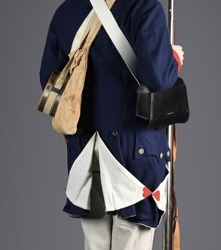
[image credit, Samson Historical and Common Threads: Army]
I have just been told the name of the triangle things, they're called vents and they're to make sure the soldiers could ride horses without messing up their uniform. :)
Epaulettes:
The epaulettes serve the same purpose as the sashes: to declare the wearers rank; however, epaulettes are much more confusing because the epaulette system changed halfway through the war. So, the epaulette system for 1776–1779 goes like this: commanders, major-generals, brigadier generals, colonels, lieutenant-colonels, and majors wore a gold epaulette on each shoulder; captains wore a single gold epaulette on their right shoulder; sub-alterns wore a single gold epaulette on their left shoulder; serjeants wore a red epaulette made of cloth on their right shoulder; and corporals wore a green epaulette made of cloth on their left shoulder. The system from 1779-1784 goes like this, commanders wore a gold epaulette on each shoulder with 3 silver stars, major-generals wore a gold epaulette on each shoulder with 2 silver stars, brigadier-generals wore a gold epaulette on each shoulder with 1 silver star, colonels, lieutenant colonels and majors wore a gold epaulette with no stars on each shoulder, captains wore a gold epaulette on their right shoulder, sub-alterns wore an epaulette on their left shoulder, senior non-commisioned officers wore a red epaulette made of cloth and adorned with a crescent moon shape made of brass on each shoulder, sergeants wore a red epaulette made of cloth on the right shoulder, corporals wore a green epaulette made of cloth on their right shoulder and lastly, privates wore no epaulettes.
Hats:
Tricorn, bicorn and round were a must. Round hats were hats that were cocked on one side, bicorn hats were hats that were cocked on two sides and tricorn hats were hats that were cocked on three sides. Most of the time Continental army soldiers pinned them and folded them on the sides. Soldiers carrying muskets wore the hat in a different way to normal civillians, civillians would have the hat the normal way, center point forward but when carrying a musket over their shoulder, soldiers would turn their hat so that the left part was facing forward. In this position, the two sides of the hat would be almost flat so they could sling their muskets over their shoulders without having to worry about knocking their hat off. The hats white edges were made using worsted wool braid and the hat itself if expensive was made of beaver felt or camel's down painted black and if it was cheap it was just made of black wool felt. Hats were not always worn, I'd say they were more of a formality because I have seen very few portraits of soldiers wearing them.
Hat Cockades:
Hat cockades were made of ribbon or wool and were a sort of decoration to be pinned to the wearer's hat. They were like sashes and epaulettes; they indicated the wearer's rank in the continental army. And the system changed in 1779. So the system before 1779 worked like this: subalterns wore a green hat cockade, captains wore a yellow hat cockade, majors and brigade majors wore a red hat cockade, colonels wore a pink hat cockade, and lieutenant colonels wore a green hat cockade. In 1779, they changed it to honour and celebrate America's military alliance with France, so the colourful insignia were removed, and instead every soldier, regardless of rank, wore a plain black and white hat cockade. French soldiers had a cockade with black in the middle, surrounded by white, and American soldiers had a cockade with white in the middle, surrounded by black. Later on, in 1783, the black and white cockades were named the union cockades and were to be worn on the left breast, close to the heart.
Shoes:
There were actually a few periods of time during the war where some of the soldiers didn't have shoes, such as during the Christmas Day crossing and the winter of 1777–1778. But when they were supplied with shoes (most of the time they were), they wore one of two styles. The classic 'little lad' shoes, as I call them, and riding boots 'Little lad' shoes were shoes made with black leather and secured with a buckle. Little lad shoes had a small heel bit at the bottom, likely meant to make the wearer look taller because, despite tall people being considered the most attractive, most people in the 18th century were very short. Riding boots had an even higher heel and a part at the top of the boots that could be rolled down to fit the wearer. When rolled down, they just look like normal riding boots but with brown cuffs at the top. Interesting shoe-related fact that I thought would be cool to put here: in the 18th century, they didn't make right or left shoes; they made what they called straights, and you were meant to switch which foot you wore them on every day to 'wear them off evenly'. Riding boots were made with leather and were black on the outside and brown on the inside. Riding boots were very tall (they went under soldiers' kneecaps) and worn for the same reason as culottes, to make horse riding easier. It's meant to prevent saddle pinching, have a sturdy toe to protect feet while on the ground, and have a big heel to prevent slipping through stirrups.
Hair:
Originally I planned on not mentioning it on this list because it's not something that you can wear but there were uniform rules about hair in the continental army so I guess it is technically part of the uniform. In the 18th century they viewed men with facial hair was considered wrong and unusual in normal day-to-day life so if course it wasn't acceptable in a military setting. In the continental army they had a rule that men needed to shave every three days. They went against this rule a few times but only when they were desperate. Now on the topic of hair as in, not facial hair, the hair on their head was usually tied into a low ponytail with a blue ribbon or - for some men - cut short. 18th century men LOVED their long hair and did not want to cut their hair short even though they were told it should prevent lice. Wigs and hair powder were fashionable in the 18th century but not many men could afford wigs and it's not like they had a ridiculous supply of hair powder so most of the time they had their natural hair colour showing.
It's important to note that this is just the standard uniform that most men wore; each regiment had its own unique uniform, so if your project has anything to do with a specific regiment, either do your own research or ask me about it in the comments or my asks. This is also post-1775 because 1775 had no uniform. If I have gotten anything wrong, please do not feel afraid to correct me in the comments, and I'll edit the post.
Sources:
https://historyofmassachusetts.org/uniforms-revolutionary-war-soldiers/
https://www.srcalifornia.com/flags/revuniforms1.htm
https://www.bostonteapartyship.com/uniforms-of-the-american-revolution
https://ufpro.com/blog/american-revolutionary-war-study-military-uniforms-across-battlefield
https://www.washingtoncrossingpark.org/continental-army-clothing/#:~:text=Over%20their%20shirts%2C%20soldiers%20would,unit%20a%20soldier%20belonged%20to.
https://www.crazycrow.com/site/tricorn-hat-history/
https://www.si.edu/object/george-washingtons-uniform%3Anmah_434863#:~:text=This%20blue%20wool%20coat%20is,buff%20wool%2C%20with%20gilt%20buttons.
http://www.colonialuniforms.com/revolutionary-war-coats.html
https://www.berkleyhistorical.org/revolutionary-war-uniform
https://www.samsonhistorical.com/en-ca/products/mens-riding-boots
https://en.wikipedia.org/wiki/Riding_boot
#american revolution#american revolutionary war#amrev#american history#revolutionary war#history#historical fashion#fashion history#18th century#18th century fashion#continental army#military history#military uniforms#war history#war of independence#On-partiality's rambles
124 notes
·
View notes
Text
Discussing Far East Winter.
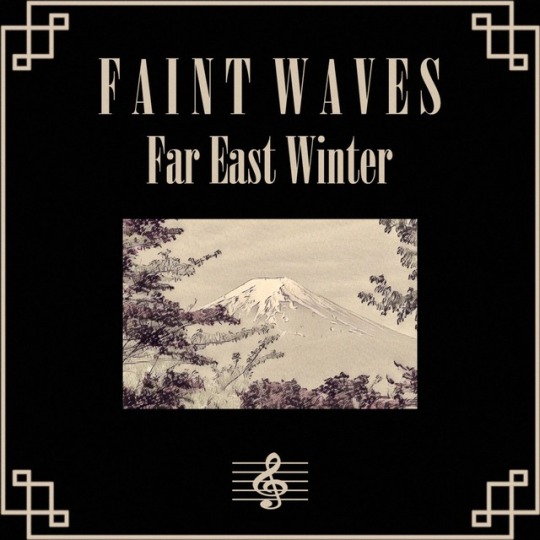
My new EP, Far East Winter has been a very interesting EP to make and because of that, I wanted to write something of an article in regards to it. So, here we are! I'm going to discuss the background of this EP, my influences, inspirations, some of the ideas I had with this record, a short run through of each track, and a few things I learned along the way. Hopefully this is an informative and interesting read and hopefully you enjoy the record, too.
I had contemplated doing an EP of this nature for some time, in fact, you can hear my earliest inclinations toward this idea on my "Cherry Blossom" single from 2017. I've always been a lover and admirer of sounds from all over the world, but music and sounds from the East and the far East have always really caught my ear. I think so many of the instruments and the scales/notation they tend to use are absolutely beautiful. The only reason I hadn't done this sooner, is because I didn't want to do this just to do it and because I'm not sure I was totally ready to. If I was going to do it, I wanted to do it some semblance of justice. If "Cherry Blossom" was me seeing if I could pull it off at all, "Far East Winter" is the more refined, realized vision of incorporating these elements into my music.
As far as who/what inspired and influenced this record, I'd say it was a good mixture of eastern and non-eastern artists. Many of my ideas were informed by Roxy Music, Prefab Sprout, Tears For Fears, Vangelis, Hiroshima, Kitaro, Hiromitsu Agatsuma, and Himekami, just to name a few. I was in a creative space where I also wanted to kind of continue the easy listening/downtempo/adult contemporary-inspired direction I've been taking Faint Waves since 2017, but I had to do something interesting to really change the pace a bit and since I wanted to do a winter release, I knew the sound couldn't just be sunshine and ocean waves. The result is a more winter-into-spring sounding EP, not necessarily dark or discordant sounding, but a bit more bittersweet and melancholy in places. That's not to say there aren't hopeful moments, as the first and final tracks on the EP are a bit more optimistic than the rest, indicating glimmers of hope amongst the moodier parts of the record.
Much of the record I think has a very soft rock and sophistipop vibe, but there are few moments that are a bit more downtempo, new age, or experimental. I also made some stylistic choices on this EP that kind of set it apart from other things I've done, namely with the drums and bass. I've often relied on a fretless bass emulation for many (the vast majority, actually) of my songs, it's been a tried and true element and staple in the music I've made. However, I felt this record warranted something different, so I've switched things up and used a finger style bass emulation. It has a much deeper sound and I think has given the record a bit more of a soft rock or vintage R&B vibe. As for the drums, I made a similar stylistic decision to go after more of an organic feel. So, rather than using solely Roland and Linn samples as I have in the past, I opted to use more live sounds. That doesn't mean I haven't used those Roland and Linn samples at all, as they're still in the mix. Many of the songs feature a live kick drum layered with a Linn kick and on "Lovers In The Cold", you can very clearly hear the use of a CR-78 hat sample alongside the rest of the drums. Small changes in the grand scheme of things but I think they've made a big difference in the overall feel of the EP.
The first song I had completed and the one that really solidified the fact that I was doing this, was "Lovers In The Cold", which ironically became the last track on the EP. "Lovers In The Cold" is a bit of a sophistipop track with both western and eastern instrumentation, including a Xylophone, Sax, an Erhu (a violin-like instrument of Chinese origin), and a brilliant emulation of the Ruan (a plucked instrument of Chinese origin). I'd say the sound and structure were most influenced by acts like Hiroshima and Roxy Music, while the blocky pad chords remind me more of Prefab Sprout. It's definitely a pretty layered track for me, lots of moving parts. The way I've always seen the song, structurally, is as an argument between two lovers. Xylophone is one party, while the Erhu is another. The Xylophone is very quick moving and aggressive but the Erhu is more relaxed and to the point. They have this back and forth, but every other time the Erhu comes in, there's one extra note that wasn't played the previous time. So, it's almost like someone is getting the last word in there. Then, you have this kind of breakdown in the song where everything slows down a bit and rather than them playing separately, you have the Xylophone and the Erhu playing simultaneously. Going along with the two lovers metaphor, that part of the song could be them reconciling, working together to make things work before everything falls apart again.
There were a lot of demos with this EP, more than maybe any other EP I've ever made. A lot of stuff didn't make the cut or just plain didn't get finished. The next track that saw completion after "Lovers In The Cold" was probably the fourth song I had made overall and it's a tracked called "Only Tonight", which was loosely inspired by "Advice For The Young At Heart" by Tears For Fears. This track was one that definitely went through a lot of changes before it became what it was. It started out very synthpop, with these big electronic strings, before I transitioned to a more organ-centric sound. It took quite a few demos for it to start to take shape as it is now, a piano ballad. I think after the organ became integral to the song, the drums were what really started to make it take shape. Those drums, at least where they start initially, have a very Burt Bacharach feel. That shaker-sidestick combo he's so fond of. It starts in that kind of Bacharach-like place but as the track goes on, the drums get a little more aggressive and eventually the sidestick is replaced with a snare. For the piano, I didn't want a big sound because the organ/bass combo was already doing that for me, so it's pretty much this continuous riff of single notes. Then the piano is accompanied by a Shamisen (a stringed instrument of Japanese origin) and later on, a sax. The track also features a Vibraphone and a Gong sample. The Vibraphone is this kind of arpeggiated-sounding series of a few notes, it really gives the track an underlying sense of movement and urgency. "Only Tonight" is an interesting one because I feel like it became what it is very naturally, but it did take some time to get there. Glad I didn't give up on it though, as it's a favorite of mine.
After that, I think came "Snow Summit", which also went through a lot of changes as it went on. It's kind of a weird one. It doesn't sound like it at all, but it was pretty Vangelis inspired. Vangelis, Yello, and Kitaro are the big inspirations for that one. It went through a lot of changes and I don't think I was ever really sure the track "worked", so to speak. Once I laid down the bass for it, I feel like it all clicked a bit better, but it's still by far one of the most oddball tracks I've ever produced. It was inspired by a Yello song called "Homer Hossa", which if you aren't familiar with, is basically just a lot of sound effects, percussion, and little actual melody. "Snow Summit" is kind of that way, except it basically has this big brass backing track accompanying all these weird sounds. I think my intention with it, is that I wanted it to be as foreboding and endless feeling as the summit of a mountain would be. You're cold, the wind is blowing, there's snow everywhere, and you can see for literally miles. That kind of thing is intimidating and I think I wanted to convey that with this noisy, aimless kind of a track. It's probably the most "experimental" thing I've done. Huge brass, eastern percussion, simulated wind, white noise stabs, and huge bass drops. That's "Snow Summit" in a nutshell.
After that, came "Hatsukoi". Hatsukoi translates to first love, if you're curious. I knew I wanted a beautiful opening song for the EP and after drawing a blank for a long time, this is what materialized. Inspired by Kitaro and to a lesser extent Himekami, "Hatsukoi" is a bit of a new age jaunt. It's basically comprised of strings, a few different kinds of percussion (both eastern and western), a Celeste, a Pipa (a four stringed instrument of Chinese origin), a Xylophone, wave sfx, and bird sfx. This track doesn't really develop beyond the first couple minutes, but I found it very lovely and relaxing and didn't feel the need to add to it. I had a few demos where a flute came in the second half but it was just overkill in my opinion. It's a bit more hopeful and warm than everything else on the EP. It's very much in line with some of the more atmospheric, new age inspired things I've done. It's very much Kitaro by way of Faint Waves, in my opinion. I'd love to explore that kind of sound more in the future, to the degree of acts like Kitaro or Himekami. That kind of Electronica-meets-New Age-and-Classical sound is always brilliant. Exploring that sort of thing could be an EP or album in it's own right, but for this release, I wanted a balance of downtempo/chilled vignettes with more deliberate/aggressive songs.
The next song that came to be was actually an older, unfinished demo that I had lying around. "Tao Of Knowing" originally started as "Charm", a new wave/sophistipop song inspired by Johnny Hates Jazz and Tango In The Night-era Fleetwood Mac. "Charm" was originally much more electronic and instead of a Koto (a stringed instrument of Japanese origin) carrying the song, it was a piano. I revisited this song during my time producing Far East Winter and I found, with a few changes, that it would fit the record. I changed quite a few things; the key changed, the chiffer lead at the beginning of the song became a Shakuhachi (a flute-like instrument of Japanese origin, derived from the Chinese bamboo flute), the main piano riff became a Koto, the poppy drum samples were replaced with the ones I was using for this EP, and I wound up writing a new pad for it as well. Once I had made those changes, the song still went through a few more permutations before it became the song you hear on Far East Winter. The song has a very mystical feel and I think that sets it apart on the EP, in a good way. The original demo had a very new wave feel to it and I think a little bit of that is still intact, particularly in the drums. This one may also be one of the more aggressive sounding songs in the Faint Waves canon, too. Very in your face at times.
The last song to be completed was "City Street". I knew from the beginning that "City Street" was going to be a short interlude kind of a song. My general vision for it from the get go was very similar to how it came to be, I knew I wanted to be very ambient and atmospheric, and to feature a Rhodes. That's exactly how it turned out but I just couldn't seem to get it to materialize. At first, I tried to make the song quicker and more urban sounding, to coincide with the name. It just wasn't working, so I scrapped almost everything except the percussion I had. The percussion I did have, I wound up changing quite a bit, leaving pretty much the bare minimum. Once I was happy with the percussion, I layered a few different sound effects. One was of nighttime ambience (crickets/frogs/etc.), another was just general city noise, and the final was of a little bit of traffic. After that came the Rhodes, which I pretty much treated almost as a pad as I wrote and produced it. I applied a lot of effects to it, reverb and delay mostly, so it would kind of linger well beyond the length of the notes would allow. On top of that, I used a Pipa again, I actually recycled a melody from another song of mine ("Congo") for that and adjusted the notes accordingly. The end result is a very soundscapey interlude that's heavy on ambiance, maybe slightly reminiscent of Kenji Kawai. Good for falling asleep to maybe, as much of my catalogue is.
In conclusion, I learned a lot going into this EP and coming out of it. I did a lot of reading and listening, trying to understand what they were doing as far as Eastern instrumentation and notation were concerned. Reading and learning about scales like the Japanese In Sen scale, as well as putting them to use, was incredibly challenging and fun. I made more songs for this one EP, than I have any release before, and it's because of what I was working with. There's a real beauty and true uniqueness to the music and culture on that side of the world that we don't often see. They do things in music that the West never has and likely, never will. I think my research and desire to understand, is what made this EP so special to me, as well as what has made the EP sound so unique in comparison to the rest of my material. I might have done some familiar things but I don't think I've ever made anything similar to what I've made here. In many ways, I feel like I needed to do a project like this, just to stretch my legs a bit and get out of my comfort zone. This record is a sign of things to come, not in the sense that I'll necessarily be making another record like this, but in the sense that my next record will be just as different. So, stay on your toes and enjoy.
- Faint Waves.
#Article#Behind The Music#Discussion#Making Of#exotica#uncategorized#world#music#adult contemporary#instrumental#balearic#downtempo#easy listening#soul#sophistipop#inspirations#review#faint waves
0 notes